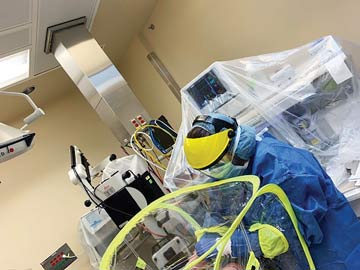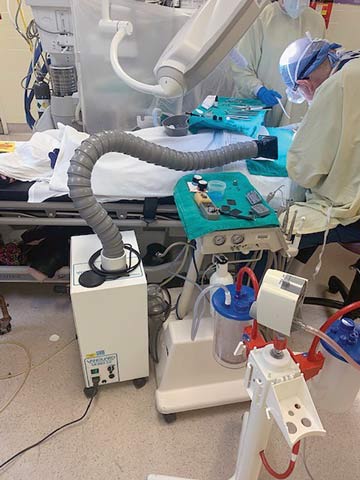As the president of a full-service anesthesia group, my number one goal has always been to protect my staff and our patients. That priority has certainly been put to the test during the pandemic. My group's providers implemented a number of new airway management policies and infection prevention protocols after the first wave hit to ensure we could continue to provide safe patient care. I believe some of the steps we've taken to minimize exposure risks to COVID-19 have improved our overall practices and should remain in place when surgery's regular routines finally return.
- Home
- The Magazine
- Article
Has COVID-19 Changed Anesthesia Care for Good?
By: Pam Wrobleski
Published: 3/9/2021
The pandemic put renewed focus on airway management and infection control practices.
Securing airways
Airway management requirements and recommendations updated during the pandemic have made us reevaluate how to best protect providers from the coronavirus, which is found in sputum and upper airway secretions and disseminated in air droplets during aerosol-producing intubations. We've tested many different safety methods, including the use of rigid and flexible clear plastic intubation boxes. Their use made sense in theory — they prevent the spread of the coronavirus by containing aerosols generated during intubation— but some studies have questioned their effectiveness, so we stopped using them on a routine basis. Instead, the providers use the boxes during cases that could cause the patient to cough.
The CDC suggests having the most experienced airway professionals on staff perform intubations. We followed that guidance and have a second anesthesia provider stationed by the OR door, closely watching the procedure and standing by ready to assist if they were needed. The CDC also recommends using video laryngoscopes during intubations in order to maintain a safe distance between the anesthesia provider and patient. Providers are able to stand upright as they view the airway on a separate screen instead of crouching inches away from the patient's mouth to get a direct view of the glottis.
Most of the newer video laryngoscopes employ disposable blades, so we've experienced a shortage of supplies during the pandemic. To combat this problem, we've had to use video laryngoscopes only on patients we thought could present more challenging intubations. We try to determine during a patient's pre-op airway evaluation if use of a video laryngoscope might be necessary by looking at the size of their neck, considering their BMI, assessing their abilities to open their mouth and extend their neck, checking their dentition and reviewing their medical records for a history of difficult intubation. Use of these video laryngoscopes has increased during the pandemic. I think more anesthesia professionals will opt to use them during routine airway management, but believe most providers will reserve them for difficult intubations.
Added protection

PPE protocols have been enhanced during the pandemic. Our anesthesia providers double-glove and remove the outer layer after performing intubations and extubations, and before touching equipment, surfaces or patients. When intubations are being performed, everyone in the room wears an N95 mask with a standard surgical mask over top of it. They must also wear eye protection, including tight-fitting goggles or face shields, and disposable isolation gowns. We experienced a shortage of PPE and a backorder on disposable gowns, so we also relied on cloth gowns that were professionally laundered.
I'll be interested to see how much protection anesthesia providers will employ during airway management after the pandemic. We've learned to adapt to wearing multiple layers, but I'm not sure the added protection will be needed moving forward. However, I'm fairly certain one aspect of PPE use will remain: The creative ways facilities have secured the protective gear they need.
Before the pandemic, we didn't keep a large stock of face shields because our providers didn't wear them for every case. We also had only a couple boxes of N95s left over from the Ebola crisis of 2014. During the first wave of the pandemic, before knowing the full extent of the impact it would have on PPE supply chains, I ordered as many items as I could. But when the first wave of the pandemic hit and supplies dwindled, we reached out to contacts at local surgical facilities. One day we'd have extra masks, but would be low on gloves, while another facility had the opposite problem. We'd help each other out if our vendors were unable to provide needed supplies.
Keeping needed supplies on hand has become a full-time job for materials managers and clinical directors. PPE supply levels are returning to pre-pandemic levels, but syringes and needles are now in short supply because of the vaccine rollout. You must think outside the box and plan ahead to make sure your team has what they need. The pandemic has likely provided you with the experience, creativity and ingenuity to make that happen. It's also forced neighboring facilities to help each other maintain adequate par levels, and I hope that willingness to collaborate continues.
Preventing the spread
During aerosol-generating procedures, we position the head of the bed away from the door to limit the number of airborne pathogens that leave the room. We also added clear plastic drapes to separate the anesthesia provider and the anesthesia machine from the surgical field, and hung signage on OR doors to restrict traffic into and out of the rooms. During upper endoscopy procedures, an aerosol-generating procedure, we employ special oxygen masks with openings for the scope to pass through while aerosols are contained.
Video laryngoscopes maintain a safe distance between the anesthesia provider and patient.
We also use a mobile high-efficiency particulate air (HEPA) filtration system designed to remove extraoral airborne particulates near the patient. The unit can be moved to different rooms for use during aerosol-generating procedures. There's not a lot of scientific evidence that shows this device is necessary, but we figure it can't hurt, especially when we're working near a patient's head in the midst of a pandemic. Taking that extra step to make patient care as safe as possible makes sense.

After procedures, patients are transported to the PACU with cloth or surgical masks worn on top of oxygen face masks. Once the patient has left the OR, staff wearing N95 masks and full PPE clean the room and set it up for the next case. The room turnover process takes an extra five or 10 minutes to complete because every surface and piece of equipment is carefully wiped down. Our anesthesia providers and surgical team members are ultimately spending an extra 30 minutes between cases readying rooms for the next case, but believe additional cleaning precautions are necessary to ensure patient safety.
It's sometimes a struggle for anesthesia professionals to keep their workstations free from contamination. During the pandemic, our providers have been constantly wiping down equipment and surfaces. We've also focused much of our attention on segregating workspaces into clean areas containing supplies we haven't yet touched and dirty areas where used items are placed. We try to keep only supplies that are absolutely needed for a case at the bedside. Supplies that may or may not be needed are stored in an enclosed cabinet in the room, kept in the hall on a cart or covered with plastic on the back table. This intense focus on maintaining clean anesthesia workstations and following proven infection prevention practices should continue after the pandemic.
Remaining focused on safety
We're back to handling a pre-coronavirus case volume at the main surgery center in which we work. In fact, the number of cases might be a little higher than normal because some procedures are shifting to the center from local hospitals that are restricting elective procedures to maintain bed capacities for COVID-19 patients.
Our anesthesia providers and surgery center colleagues call patients before their procedures to screen for symptoms of COVID-19. They also call on the day of surgery to remind them of the facility's safety policies related to masking, limiting visitors and social distancing.
My group is stretched thin, but we continue to work hard. Thanks to the new policies and practices we've implemented, none of us have tested positive for COVID-19 due to workplace exposure. Nobody knows how the pandemic will play out or when it will end, but it's certain our delivery of safe anesthesia care will continue. OSM
.svg?sfvrsn=be606e78_3)
.svg?sfvrsn=56b2f850_5)